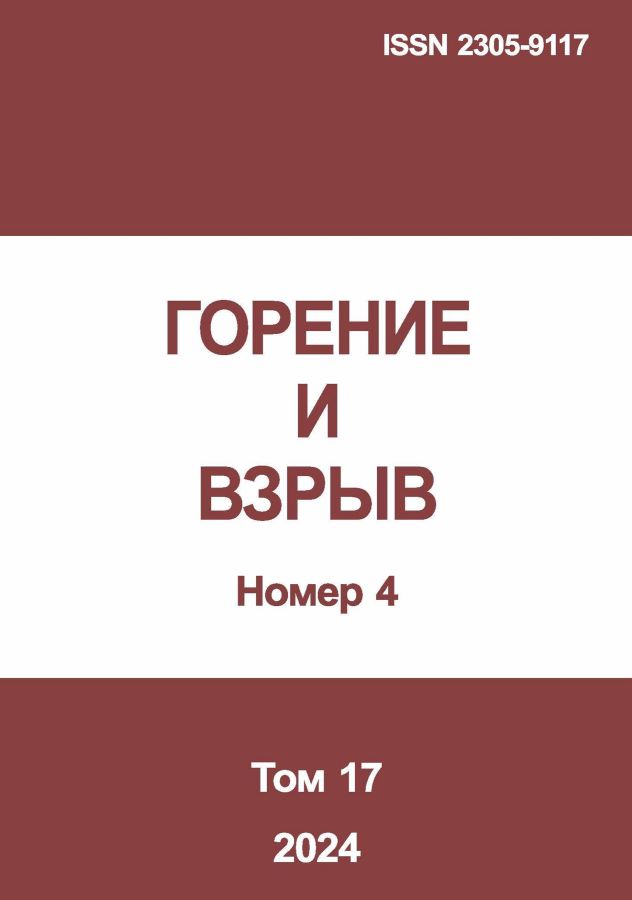Изучение влияния трехмерности на стабилизацию фронта пламени в дозвуковом течении с перемешанным горением
- Авторы: Балабанов Р.А.1,2
-
Учреждения:
- Московский физико-технический институт
- Центральный аэродинамический институт им. проф. Н. Е. Жуковского (ЦАГИ)
- Выпуск: Том 17, № 4 (2024)
- Страницы: 15-28
- Раздел: Статьи
- URL: https://bakhtiniada.ru/2305-9117/article/view/284248
- DOI: https://doi.org/10.30826/CE24170402
- EDN: https://elibrary.ru/NSMKDK
- ID: 284248
Цитировать
Аннотация
Представлены результаты трехмерных расчетов эксперимента P. Magre et al. (ONERA) с горением предварительно перемешанной метановоздушной смеси в модельном канале с уступом. Расчеты производились с моделью EPaSR (Extended Partially Stirred Reactor (PASR)) для учета влияния турбулентности на среднюю скорость реакций горения. Обсуждаются проблемы, связанные с переходом к небуссинесковым моделям класса DRSM (Differential Reynolds Stress Models). Предложено решение проблемы отсутствия производства кинетической энергии турбулентности на фронте пламени, возникающей в расчетах с DRSM моделями. Показано существенное влияние небуссинесковой модели на структуру течения в поперечных сечениях. Показано влияние поперечной неравномерности поля скорости на образование области проскока пламени вверх по потоку. В результате применения двухканальной модели взаимодействия турбулентности и горения EPaSR-PrOm показано, что наличие теплоотвода на боковых стенках существенно влияет на поле турбулентных чисел Прандтля, уменьшая их значения по сравнению с двумерным расчетом.
Ключевые слова
Полный текст
Об авторах
Роман Алексеевич Балабанов
Московский физико-технический институт; Центральный аэродинамический институт им. проф. Н. Е. Жуковского (ЦАГИ)
Автор, ответственный за переписку.
Email: balabanov.ra@phystech.edu
(р. 1999) — аспирант Московского физико-технического института; инженер Центрального аэродинамического института им. проф. Н. Е. Жуковского (ЦАГИ)
Россия, 9 Institutsky Lane, Dologoprudny 141701, Moscow Region; 1 Zhukovsky Str., Zhukovsky 140180, Moscow RegionСписок литературы
- Magre P., Moreau P., Collin G., Borghi R., P alat M. 1987. Further studies by CARS of premixed turbulent combustion in a high velocity flow // Combust. Flame, 1987. Vol 71. No. 2. P. 147–168. doi: 10.1016/0010-2180(88)90004-1.
- Балабанов Р. A., Власенко В. В., Ноздрачев А. Ю. Описание предварительно перемешанного турбулентного горения в канале со ступенькой при помощи моделей класса PaSR // Физика горения и взрыва, 2024. Т. 60. № 4. С. 44–45. doi: 10.15372/FGV2024.9453.
- Lewis B., von Elbe G. Combustion, flames and explosions of gases. — 3rd ed. — Orlando, FL, USA: Academic Press, 1987. 740 p.
- Matyushenko A. A., Garbaruk A. V. Non-linear correction for the – SST turbulence model // J. Phys. Conf. Ser., 2017. Vol. 929. P. 012102. doi: 10.1088/1742-6596/929/1/012102.
- Cecora R.-D., Radespiel R., Eisfeld B., Probst A. Differential Reynolds stress modeling for aeronautics // AIAA J., 2015. Vol. 53. No. 3. P. 739–755. doi: 10.2514/1.J053250.
- Pettersson Reif, B., Andersson H. Prediction of turbulence-generated secondary mean flow in a square duct // Flow Turbul. Combust., 2002. Vol. 68. P. 41–61. doi: 10.1023/A:1015611721026.
- Oh M. T. Assessment of Reynolds stress turbulence closures for separated flow over backward-facing step // Transactions Korean Society Mechanical Engineers, 1995. Vol. 19. No. 11. P. 3014–3021. doi: 10.22634/ KSME.1995.19.11.3014.
- Gibson M. M., Launder B. E. 1978. Ground effects on pressure fluctuations in the atmospheric boundary layer // J. Fluid Mech., 1978. Vol. 86. No. 3. P. 491–511. doi: 10.1017/S0022112078001251.
- Petrova N. Turbulence chemistry interaction models for numerical simulation of aeronautical propulsion systems: PhD Diss. — Palaiseau: Ecole polytechnique, 2015. 316 p.
- Ширяева А. А. 2018. Моделирование высокоскоростных течений со смешанными режимами турбулентного горения на основе трехмерных уравненийРейнольдса. Дис. ... канд. физ.-мат. наук. — Жуковский, 2018. 217 c.
- Fureby C. Comparison of flamelet and finite rate chemistry LES for premixed turbulent combustion. AIAA Paper No. 2007-1413, 2007.
- Балабанов Р. А., Власенко В. В., Ширяева А. А. Опыт валидации моделей турбулентного горения класса PaSR и планы развития этих моделей применительно к камерам сгорания газотурбинных установок // Горение и взрыв, 2022. Т. 15. № 4. С. 48–57.
- Ferrarotti M., Li Z., Parente A. On the role of mixing models in the simulation of MILD combustion using finite-rate chemistry combustion models // P. Combust. Inst., 2019. Vol. 37. No. 4. P. 531–4538. doi: 10.1016/ j.proci.2018.07.043.
- Menter F. R. Two-equation eddy-viscosity turbulence models for engineering applications // AIAA J., 1994. Vol. 32. No. 8. P. 1598–1605.
- Menter F. R., Kuntz M., Langtry R. Ten years of industrial experience with the SST turbulence model // Turbulence Heat Mass Transfer, 2003. Vol. 4. No. 1. P. 625–632.
- Sabelnikov V., Fureby C. LES combustion modeling for high Re flames using a multi-phase analogy // Combust. Flame, 2013. Vol. 160. No. 1. P. 83–96. doi: 10.1016/j.combustflame.2012.09.008.
- Басевич В., Беляев А., Фролов С. «Глобальные» кинетические механизмы для расчета турбулентных реагирующих течений // Химическая физика, 1998. Т. 17. № 9. С. 117–129.
- Libby P. A., Bray K. N. C. Countergradient diffusion in premixed turbulent flames // AIAA J., 1981. Vol. 19. No. 2. P. 205–213.
- Zhang S., Rutland C. J. Premixed flame effects on turbulence and pressure- related terms // Combust. Flame, 1995. Vol. 102. No. 4. P. 447–461. doi: 10.1016/0010-2180(95)00036-6.
- Sabelnikov V. A., Lipatnikov A. N., Nishiki S., et al. Dissipation and dilatation rates in premixed turbulent flames // Phys. Fluids, 2021. Vol. 33. No. 3. doi: 10.1063/5.0039101.
- Lindstedt R. P., Vaos E. M. 1999. Modeling of premixed turbulent flames with second moment methods // Combust. Flame, 1999. Vol. 116. No. 4. P. 461–485. doi: 10.1016/S0010-2180(98)00058-3.
- Lebedev A. B., Yakubovskii K. Y., Toktaliev P. D. Numerical modeling of steady and unsteady combustion regimes of methane–air mixture in research combustion chamber with step // J. Phys. Conf. Ser., 2018. Vol. 1261. No. 1. P. 012020. doi: 10.1088/1742-6596/1261/1/012020.
Дополнительные файлы


















